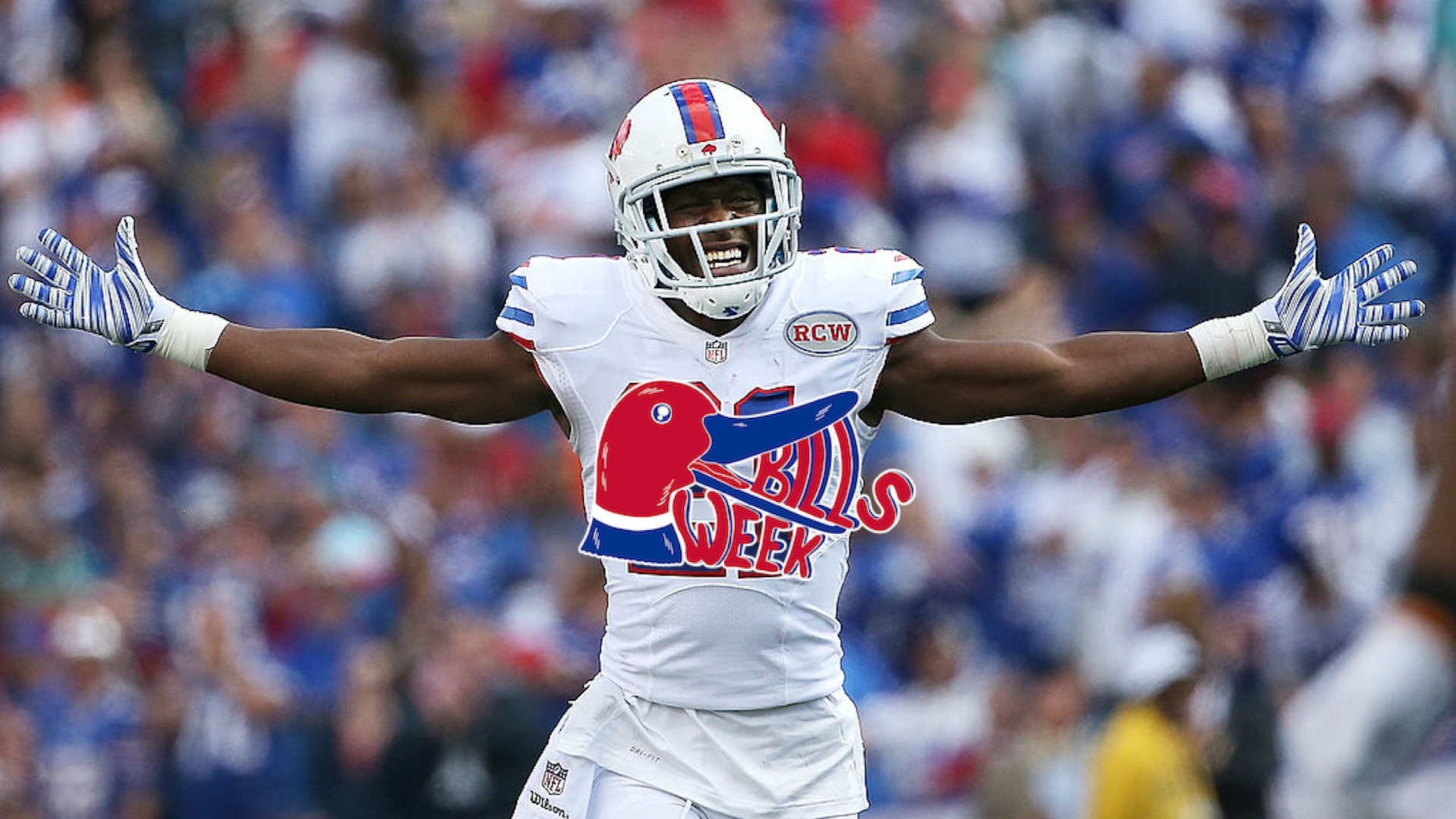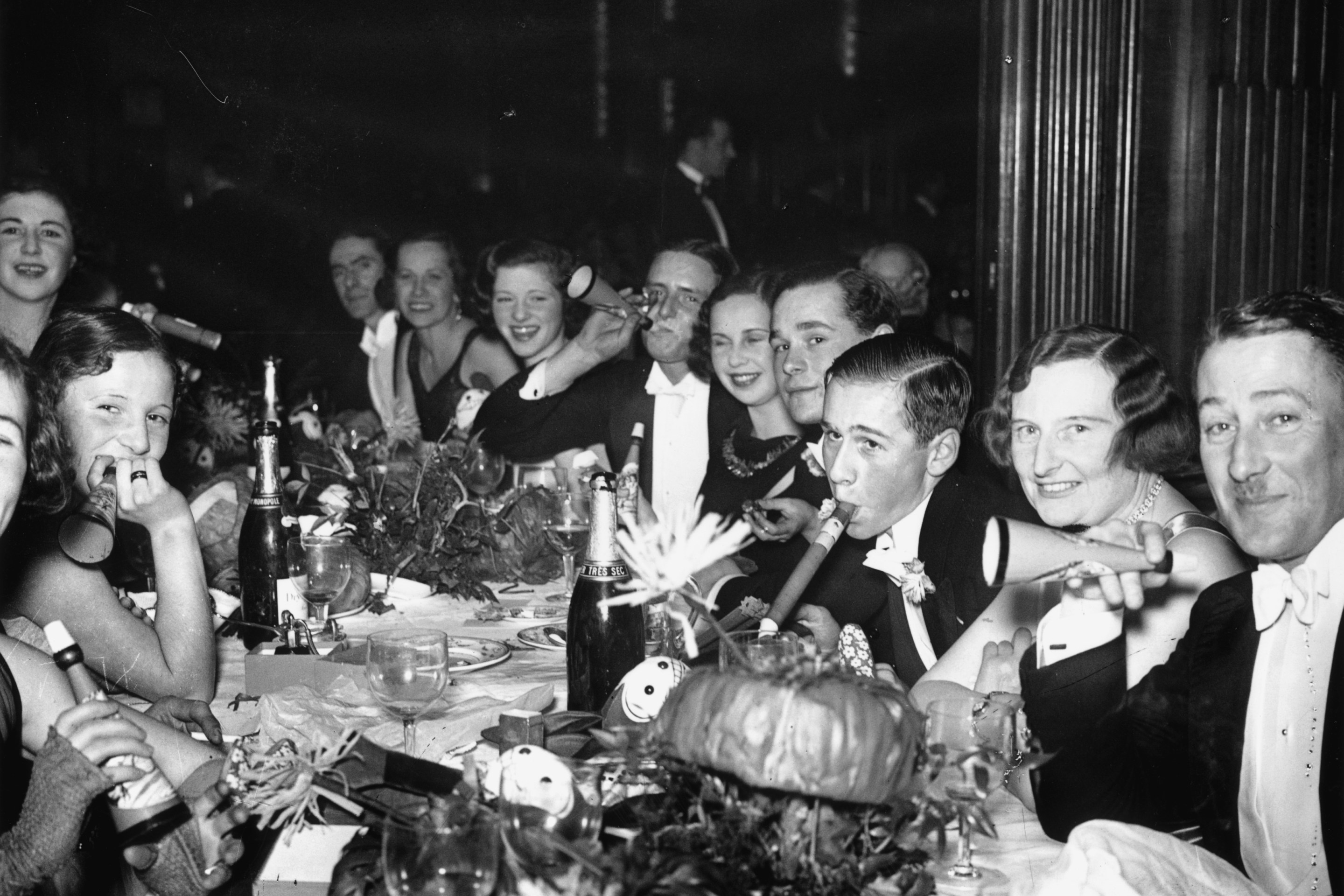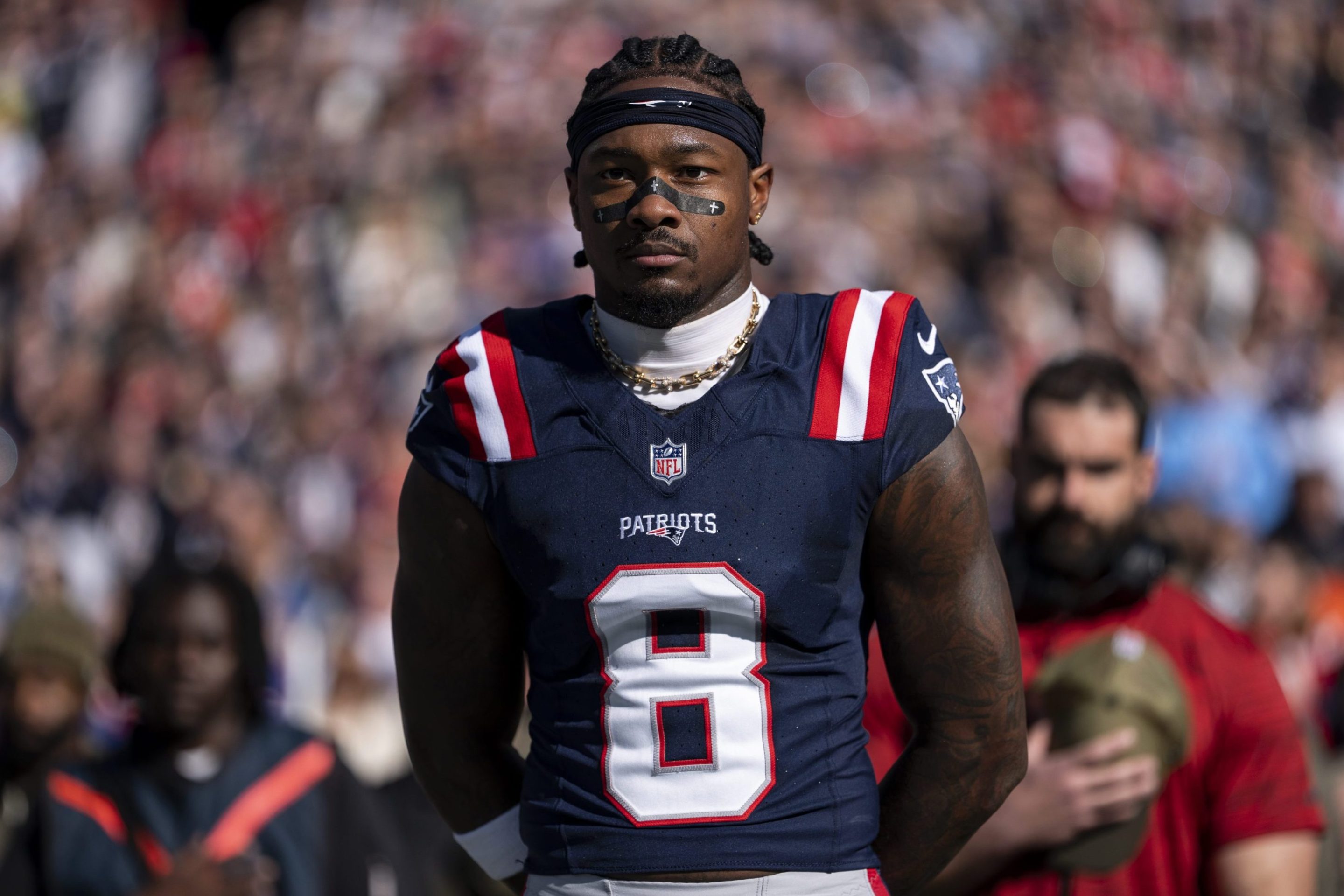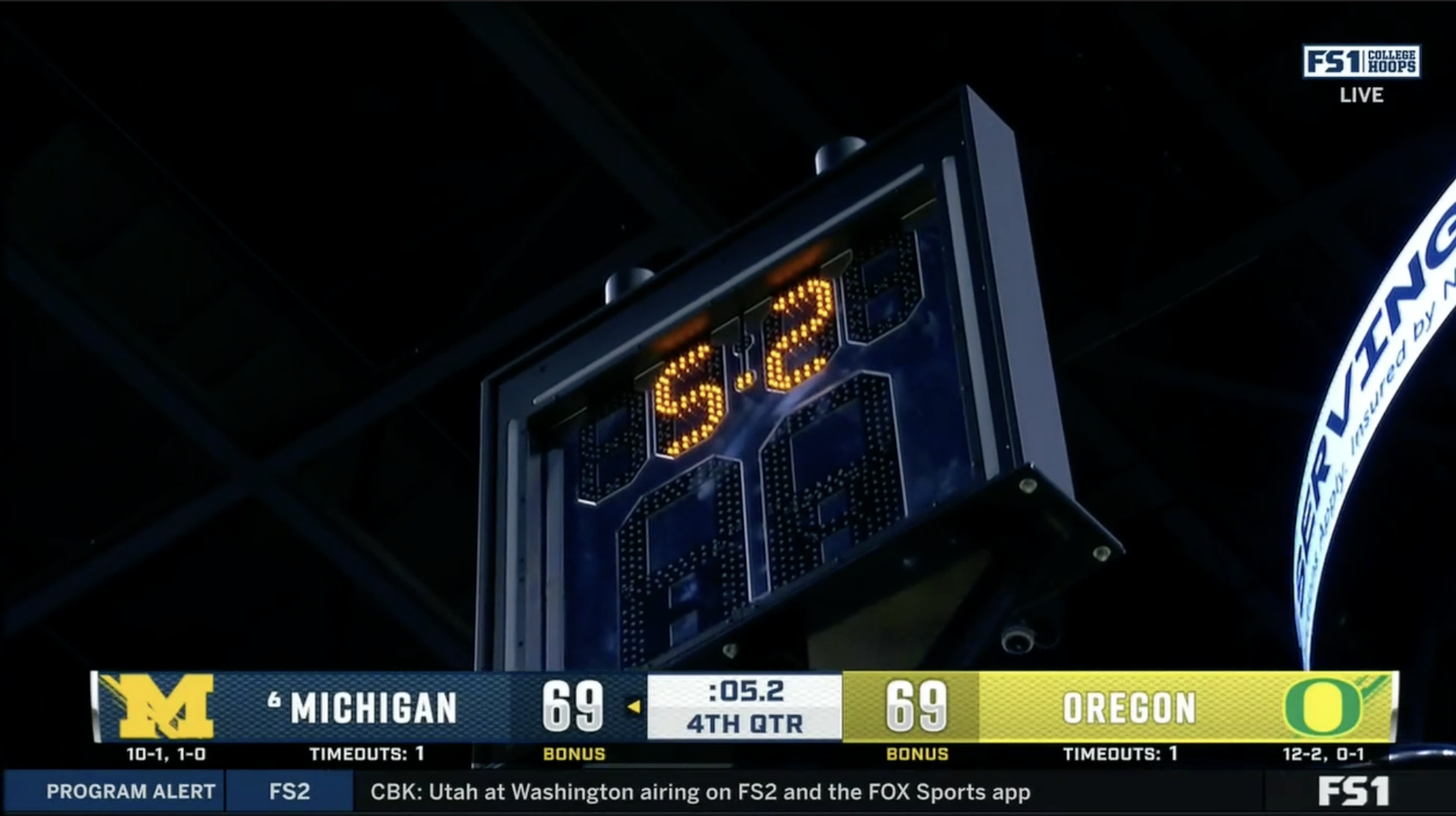The Buffalo Bills of my childhood are not the Buffalo Bills I live with now. They are certainly not the Buffalo Bills I’ve written about before on this website.
It’s weird to think about in retrospect. The Bills went from clockwork ineptitude to clockwork competence with only a handful of transition years in the middle, from the team I finally saw suit up for a playoff game when I was 19 years old to the team that has won five division titles in a row. From the basement to the top of the league.
In some ways, these Buffalo Bills—the ones that push the AFC East around, the ones that regularly make deep playoff runs—don’t exactly feel like my Buffalo Bills. The lovable losers I came of age with produced countless fascinating players, fascinating stories, and exactly zero playoff football teams. Sometimes they’d have a new exciting quarterback; sometimes they’d cart out Trent Edwards again. Sometimes they’d start strong and finish weak, or start off pitiful and roar to life down the stretch. No matter what, the outcome was predetermined: 6-10 or 7-9, a team part of the “In The Hunt” playoff graphic in November. It was comforting, in a way. Safe. Predictable. Easy.
To celebrate Bills Week, I’d like to remember my Buffalo Bills with all of you. Without further ado!
Takeo Spikes – Linebacker, 2003-2006
Let’s start off easy, with a player everybody knows and loves. Spikes was the rare aughts-era Bills free-agent signing that actually worked, as he turned in the two best seasons of his career in Buffalo in 2003 and 2004. There’s a lot to remember here: Spikes had a sick name, he played linebacker at the height of that position’s coolness in the physical run-first aughts, and he made big plays that look fucking incredible in crunchy highlight-package format.
You still see the occasional Takeo Spikes jersey around Buffalo, even 20 years later. For somebody who was never a proper superstar, that’s unbelievable staying power.
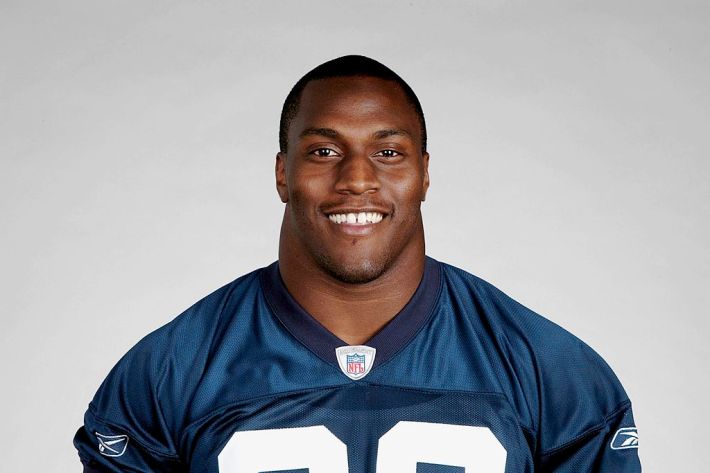
This is not a man I want problems with. Love you, Takeo.
Bacarri Rambo – Safety, 2014-2015
Bacarri Rambo.
Bacarri Rambo.
Bacarri Rambo!
Bacarri Rambo could make this list on name alone, but I want to highlight the thing for which Bills fans remember him most. Added halfway through the 2014 season, Rambo made his Bills debut by playing a few snaps in Week 12, then went back to the bench. He finally got serious playing time in Week 15 against the Packers, filling in for the injured Da’Norris Searcy (also a guy to remember!) in a platoon role.
In his first significant playing time for the Bills, Bacarri Rambo picked off Aaron Rodgers. Twice. In one game.
I get that the guy is a punchline in 2025, but you have to appreciate what a monumental achievement it was to pick off Aaron Rodgers once in the mid-2010s, let alone twice. Rodgers was phenomenal in 2014, on his way to a second MVP award. Over the entire season, he threw five interceptions. Forty percent of his picks that year went to a backup safety.
A backup player getting two interceptions in one game? Incredible. Unlikely. Getting those interceptions off prime Aaron Rodgers, who will likely retire with the lowest interception percentage of any quarterback in NFL history? Absolutely fucking impossible. But Bacarri Rambo did that, because Bacarri Rambo does not care what you or I think is impossible.
Lastly, I hope his middle name is pronounced Jamón.
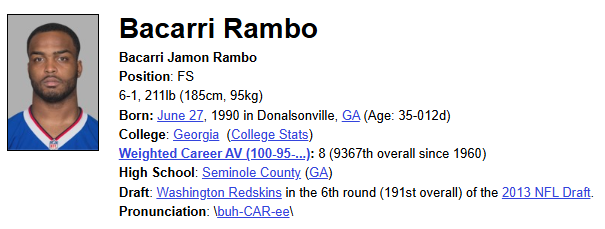
Larry Centers – Fullback, 2001-2002
Did you know Larry Centers played for the Bills? He did! Signing a 33-year-old Pro Bowl fullback was Buffalo’s big splash in 2001, which is all you need to know about the 2001 Buffalo Bills. Centers was their third-leading receiver, just behind Eric Moulds and Peerless Price with 80 receptions on 105 targets, 620 yards, and a pair of touchdowns. The Bills were so pleased with his play that they signed him to an extension (per this fossil of an ESPN article from 2002; the internet used to be so cool) that made him a million-dollar player.
As someone who first started watching football in the mid-to-late aughts, it’s hard to wrap my head around Larry Centers’s career.
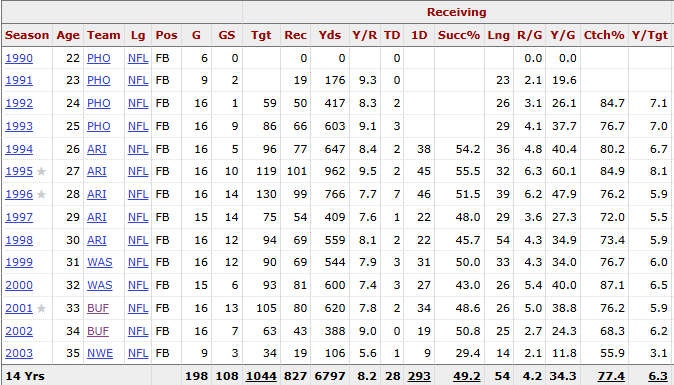
This is a brand of football player that does not exist anymore. Football trends are cyclical, of course, but I think I can go ahead and call it: The 2001 Buffalo Bills are the last NFL team that will ever target a fullback 100-plus times in a single season. For this—and for being forced to catch passes from Alex Van Pelt, certified Big Boy Icon—I’m happy to remember you, Larry.
Brian Moorman – Punter, 2001-2013
There’s never been another punter quite like Brian Moorman. On paper, you could squint and see a perfectly normal special teamer: blindingly Caucasian, rail-skinny, exquisitely bald in his 20s. He looked like a kind but stern social studies teacher at age 25.
The secret, though: Brian Moorman was a Division II national champion hurdler for Pittsburg State (go Gorillas) in the late ‘90s. This goofy-ass white boy could fucking move.
yall wanna see a fake punt?
— victoria zeller (buy ONE OF THE BOYS) (@dirtbagqueer.rocks) 2025-07-09T18:22:02.556Z
Moorman’s first step is still jarring to me, all these years later. Punters are not supposed to move like that! The Bills of the aughts, desperate to get anything going on offense, called on Moorman for the fakes all the damn time, leaving him with five career first downs on the ground. He also threw touchdowns to backup defensive end Ryan Denney on fake field goals in ’08 and ’09, something I will never get over. How’d they pull it off twice? Why throw it to Ryan Denney?
This is all, of course, how Moorman ended up as a crash test dummy in the most famous highlight in Pro Bowl history. Most people know this clip, but what they don’t know is that Moorman wasn’t just some poor dipshit sacrificed to Sean Taylor; he ran this fake punt because he fucking earned it. In a way, everything that made Brian Moorman unique and brilliant is memorialized in this one play, just as it is with the late Sean Taylor. I think that’s beautiful.
Intermission: Let’s remember some alliteration
Brian Brohm – Quarterback, 2009-10
Chris Kelsay – Defensive end, 2003-2012 (yes this counts, the sounds are alliterative)
Marcus Murphy – Running back, 2017-2018
Robert Royal – Tight end, 2006-2008
Peerless Price – Wide receiver, 1999-2002, 2006-2007
Pierson Prioleau – Safety, 2001-2004
Tyrod Taylor – Quarterback, 2015-2017
Derrick Dockery – Guard, 2007-2008 (formerly a Paul Ryan employee!)
Paul Posluszny – Linebacker, 2007-2010 (currently a Raytheon employee!)
Roscoe Parrish – Wide receiver, 2005-2011
Roscoe Parrish was fucking sick. I distinctly remember Bills fans being frustrated with his ball-security issues and lack of offensive production, but he was an absolute demon in the return game. The guy whipped his body around like a marionette, had a lethal first step, and absolutely flew at top speed.
I don’t want to overtalk this one. Let’s watch some punt returns.
Perfect football player. 10/10, no notes.
Stevie Johnson – Wide receiver, 2008-2013
There’s an easy way to talk about Stevie Johnson that a lot of people default to, and I get it. He’s the guy that blamed God for a dropped touchdown and pretended to shoot himself in the leg one time to taunt Plaxico Burress. You can’t tell the story of the guy without all that, but I hate when they overshadow what I know about Stevie Johnson: that in terms of sheer craft, he’s still one of the greatest football players I’ve ever seen.
Stevie Johnson was an artist, a real wide receiver’s wide receiver. He spent his short (and spectacular) prime singling out and embarrassing elite cornerbacks like Darrelle Revis and Richard Sherman. Garrett Wilson modeled his game after him. Johnson crawled up from the bottom of the depth chart and put up three straight 1,000-yard seasons catching passes from Ryan Fitzpatrick, and he did it with a 4.58 40-yard dash and a 32.5-inch vertical. He won with impossibly crisp routes, a knack for making impossible catches, and pure spite.
As quick as he burst onto the scene, Johnson vanished. After a down year in 2013, the Bills shipped him to San Francisco, where he struggled to stand out in a receiver room that included Anquan Boldin and Michael Crabtree. After another middling season in San Diego plagued by injuries, it was over. Johnson played his last NFL game at 29, and his résumé will never reflect the talent readily apparent to everyone who watched him, or played against him.
Stevie Johnson was a man out of time. If you look at his highlights, you see him running Chan Gailey’s West Coast/spread staples: slants, digs, quick outs, the occasional wheel or go. If he’d had been born 10 years later, he could’ve been a lethal perimeter receiver in a Kyle Shanahan offense, putting his route running and ball skills to good use on deeper crossing routes. His tape has flashes of Puka Nacua, Jauan Jennings, Cooper Kupp. In a world where his skillset was more understood while he played—and the Bills didn’t suck so hard—we’d look at him as one of the greatest receivers of his generation.
As it is, Stevie Johnson’s the Velvet Underground of NFL wide receivers. Only 500 people watched him play, but they all became football dorks.
Marcus Buggs – Linebacker, 2008-2009
I know what you’re thinking: I don’t remember Marcus Buggs! His Wikipedia page is three sentences long, after all, and he only ever played in nine career games. But I remember Marcus Buggs, and I want to tell you why.
Buggs, if you don’t know, was a linebacker. He grew up in Nashville, stayed home for college at Vanderbilt, and signed with the Bills as an undrafted free agent in 2008. After spending most of 2008 on the practice squad, he impressed the Bills enough to make the roster out of training camp in 2009. Injuries led him to crack the starting lineup early in the season, filling in at the Mike despite being tiny by 2000s-linebacker standards.
This brings us to Buggs’s greatest moment: Week 5, Browns-Bills. This is the worst football game I’ve ever seen—I did a whole podcast about it!—but that’s beside the point. It’s a key third down for the Browns at midfield early in the second quarter, and defensive coordinator Perry Fewell dials up a blitz. Marcus, gunning for his first career sack, shoots the gap and brings the fucking house down.
Wait. WAIT. WAIT NO—
A quarter and a half later, Buggs would be carted off with a left knee injury. The Bills placed him on IR, and that was that. He spent the next preseason with the Chicago Bears, but he never played another NFL snap. He never got his sack.
Football is a cruel game, one full of stories like this. It asks players to give everything they’ve got, chews them up, and spits them back out into a world it hasn’t prepared them for. It’s a machine with gears lubricated by human misery, and it’s also a game I happen to love. I’ve never been able to make sense of that. I don’t think anybody with an honest and clear-eyed relationship with the game can.
The least we can, I figure, is celebrate players like Marcus Buggs. These days, he’s a successful restaurateur back in his hometown of Nashville. I don’t know if I’ll ever visit Nashville, but if I do, I hope I’ll get to try out one of his spots. If I get lucky, I’ll be able to tell him face to face that I remember him fondly.
Intermission 2: Guys I couldn’t shoehorn into the first intermission and don’t want to write about but refuse to leave unremembered
Aaron Schobel – Defensive end, 2001-2009
Boobie Dixon – Running back, 2014-2015
Arthur Moats – Linebacker, 2010-2013
Terrence McGee – Cornerback, 2003-2012
Coy Wire – Safety/linebacker, 2002-2007
Sam Gash – Fullback, 1998-1999, 2003
Ko Simpson, who is worth millions – Safety, 2006-2008
Kiko Alonso – Linebacker, 2013-2014
Jabari Greer – Cornerback, 2004-2008
Jairus Byrd – Safety, 2009-2013
George Wilson – Safety, 2004-2012
Leodis McKelvin – Cornerback, 2008-2015
It does not get any more quintessentially Playoff-Drought Buffalo Bills than Leodis McKelvin. He is the apotheosis, the final boss. He is a wonderful guy to remember, and there’s so much to the story that I have no choice but to organize my thoughts in a numbered list.
- He has an incredible name. Leodis McKelvin. Say that aloud to yourself a few times, appreciate its rhythm and mouthfeel. This is a huge win for nominative determinism, because only an NFL cornerback could possibly be named Leodis McKelvin.
- The Bills drafted him 11th overall of Troy in 2008, and he made a splash immediately. He scored a pick-six and a kick-return touchdown in his rookie season, showing us right away what makes him special. On both defense and special teams, McKelvin was a magnet for big plays, with the ball skills, vision, and speed to make other teams pay for daring to put the ball in his hands.
- McKelvin also made big mistakes. He bounced in and out of the lineup early in his career, his flashes of brilliance always countered with mind-boggling lapses. He had a knack for covering receivers perfectly but not being physical enough to break up passes, or for completely losing his man in traffic. He also fumbled 17 times in his career, a number that stretches believability when you consider he was only ever a cornerback and part-time returner. Most famously, a fumbled kickoff on Monday Night Football in Foxborough in 2009 enabled a furious comeback win for the Patriots. Bills fans were horrible about it. All these years later, they’ll still bring it up if you mention his name.
- He has an incredible voice. Seriously, he sounds like if Boomhauer was from Georgia.
My favorite Leodis McKelvin quote of all time #BUFvsMIA #PointBlankPeriod pic.twitter.com/VrBvnsBYIG
— David Kramer (@DavidKramer93) November 2, 2015
- McKelvin was dropped from the lineup for his inconsistency by 2011, with the team drafting Aaron Williams and Stephon Gilmore in consecutive years in an effort to replace him. He managed to stick around by polishing his skills as a punt returner, rewarding the Bills for their patience. He scored three punt-return touchdowns between 2011 and 2012, started a handful of games on defense thanks to injury, and wrote himself back into Bills Mafia’s good books.
- Six years into McKelvin’s career, he did the impossible: He became a good perimeter cornerback. He won his starting job back in 2013, and under the tutelage of Mike Pettine (and later Jim Schwartz), McKelvin finally blossomed into the player he was always supposed to be. Starting alongside Gilmore and Nickell Robey-Coleman, McKelvin was brilliant in 2013 and 2014, with five interceptions and 27 pass deflections across both seasons. You could call him a late bloomer, but Leodis McKelvin is never late. He arrives precisely when he means to.
- The man was a quote machine. Hey, Leodis, what was your first thought after you fumbled? “Oh shit, I fumbled.” How do you think you'll do against the Dolphins this week? "Shit, we're gonna go out and beat that ass. Point blank. Period.” What happened against the Giants this week, Leodis?
Leodis McKelvin, ladies and gentleman. (@bliv94) pic.twitter.com/Uqz5xLyVIi
— Joe Giglio (@JoeGiglioSports) November 7, 2016
Thank you for your honesty, Leodis. I have no further questions.
- Hitting your prime at age 29 has its risks. McKelvin broke his ankle in November 2014, and suffered setbacks in his recovery that kept him sidelined for almost an entire calendar year. Despite making good starts late in 2015, the infinitely wise and brilliant Rex Ryan deemed him a poor fit for his scheme. The Bills released him in March. McKelvin followed Schwartz to Philadelphia in 2016, had one last up-and-down season, and retired at age 31.
Leodis McKelvin’s eight-year odyssey in Buffalo took him through the regimes of Dick Jauron, Chan Gailey, Doug Marrone, and Rex Ryan. He was a promising rookie, a first-round bust, a dynamic special teamer, and a wily veteran cornerback for some seriously talented defenses. He played with J.P. Losman, Tyrod Taylor, and everyone in between. All the way, he was himself: always smiling, always dropping incredible quotes, always working his ass off to get better.
Thank you, Leodis. I’m proud you wore the blue and red.
